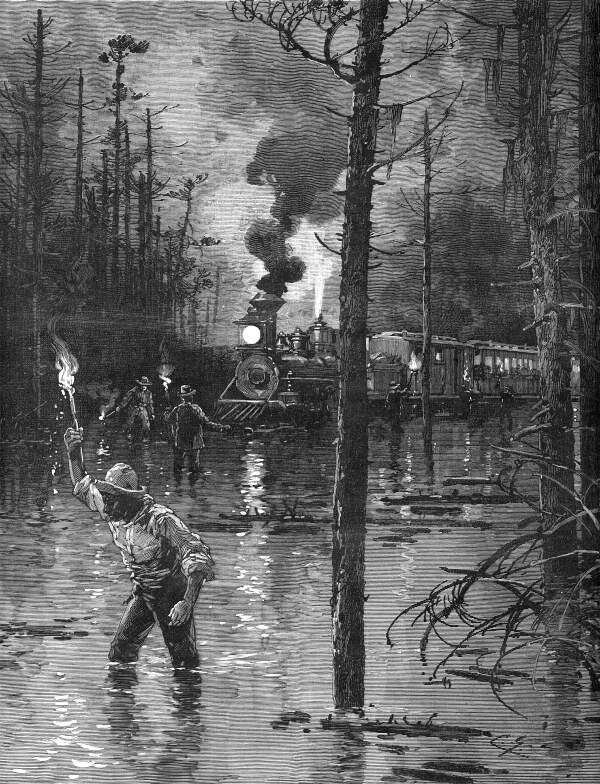|
THE SPRING FLOODS.—Harper's Weekly—April 17, 1886
Brought to a Stand-Still—An
Incident of the Floods in Alabama
Drawn by Charles Graham From a Passenger's Notes
 THE certainty with which vast sections
of the country are annually inundated by spring freshets raises
the important question, "Cannot engineering skill do something
to lessen if not to avert the stupendous damage which follows
regularly at this season of the year upon the rising of rivers
north, east, south, and west?" There is hardly a spring during
which Congress is not petitioned to appropriate money for the
relief of sufferers by flood. Thus far this year the greatest
suffering and loss of property have occurred in the South, and
Congress was recently invited to set apart $300,000 for the victims
of an overflow along the rivers of Alabama. THE certainty with which vast sections
of the country are annually inundated by spring freshets raises
the important question, "Cannot engineering skill do something
to lessen if not to avert the stupendous damage which follows
regularly at this season of the year upon the rising of rivers
north, east, south, and west?" There is hardly a spring during
which Congress is not petitioned to appropriate money for the
relief of sufferers by flood. Thus far this year the greatest
suffering and loss of property have occurred in the South, and
Congress was recently invited to set apart $300,000 for the victims
of an overflow along the rivers of Alabama.
Beginning with the floods in New England in February, when
a large portion of the city of Boston was submerged (as was illustrated
in HARPER'S WEEKLY at the time), the record of damage by water
in different parts of the Union has been almost continuous and
certainly appalling. Simultaneously on the first day of this month
floods were reported from Vermont, New Hampshire, Virginia, North
Carolina, Tennessee, and Alabama. At Montpelier, Vermont, the
Winooski River rose to a height unequalled since 1869, and the
town of Lancaster, New Hampshire, was inundated by a sudden rising
of the Israel River. The report of these disasters was, however,
overshadowed by the tidings of destruction that came from the
South. Along the lines of the Alabama and Coosa rivers in Alabama
the destruction of property was tremendous, and human life was
jeopardized in all directions. The floods were most severely felt
in Coosa, Elmore, Montgomery, Autauga, and Dallas counties. The
county-seat of Elmore and the country around it were quickly reduced
to a most deplorable state. Water stood four feet deep in the
business houses of many of these Alabama towns and people were
driven by the hundreds from their places of residence. The loss
of life, as is usually the case at such times, was at first sensationally
reported to be very great, but later details of the flood showed
that there had been but comparatively few instances of drowning
of human beings, although thousands of horses, mules, cattle,
and hogs were swept away. The rise of the Alabama and Coosa rivers
was followed by the rising of the Warrior and Tallapoosa rivers,
and relief boats were sent out from Montgomery, and brought in
hundreds of persons who had been in peril and without food for
several days. The flood at Montgomery was said to have been higher
by six feet than ever before known. From the dome of the State
Capitol on April 2 could be seen, stretching away to the north
and west, a lake of water fully ten miles square. The gas works
and electric-light works were flooded, and the only means of illuminating
the city for several days was by the use of candles and oil lamps.
The loss of life throughout the State was mainly confined to colored
people who had occupied little cabins and huts on the banks of
the swollen rivers, although the owners of one or two prosperous
farms in the low lands are known to have perished. A convict farm
in Elmore County was flooded, and the convicts were taken off
in rafts, many of them escaping. Every bridge and several important
mills in Elmore County were totally destroyed. Unparalleled suffering
was reported front the little town of Selma, Alabama, in the neighborhood
of which place, along the line of the Alabama River, the loss
of life among the poor colored people was the greatest. Relief
committees were promptly organized throughout the State, but the
supply of money and of provisions was totally inadequate to the
demands of the sufferers. Meantime other Southern States had not
escaped the flood. Reports from Chattanooga and Nashville showed
great suffering and damage in Tennessee. Four thousand persons
in Chattanooga were rendered homeless, and were carried in boats
straight across the inundated city to the dry and historic heights
of Lookout Mountain and Missionary Ridge. By the rising of the
James and Appomattox rivers a number of towns and cities in Virginia
were also flooded. In Richmond the water rose to a depth of four
feet on the main street, and relief boats were kept in motion
day and night rescuing the terrified inhabitants.
Mother Nature
| 50 Years on the Rail
| Contents Page
|







